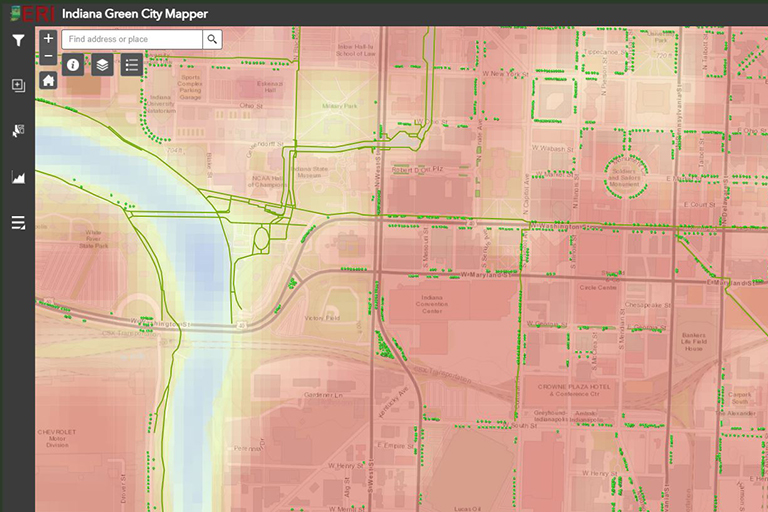Arbor Day in Indiana may have started as a celebration of trees, but in a time of rampant environmental change, it’s also a celebration of resilience.
A new tool created by Indiana University researchers is helping Indiana local governments maximize the benefits of urban trees and other green infrastructure to become more resilient against the impacts of climate change.
Indiana Green City Mapper, a statewide spatial inventory, charts six forms of green infrastructure—urban forests, green roofs, parks, greenways and trails, urban food gardens, and green stormwater infrastructure—across Hoosier communities, pairing this information with socioeconomic and climate change-related data to help inform resilience planning. By leveraging natural systems, community decision makers can economically reduce risks posed by climate change impacts, such as increased precipitation and hotter temperatures. The project was funded by IU’s Environmental Resilience Institute.
“Green infrastructure is an incredibly important and powerful way to address climate change challenges,” said Heather Reynolds, an associate professor in IU’s Department of Biology and project co-lead. “Just as cities and towns have resources to manage gray infrastructure—things like paved surfaces, buildings, and sewers, they also need resources to manage green infrastructure. Indiana Green City Mapper brings all of this data under one roof, giving Hoosier communities a comprehensive view of their green assets and the assets of surrounding municipalities.”
Currently, the mapper contains detailed green infrastructure data for Indianapolis and Bloomington and urban forest data for 27 Indiana cities and towns. Users can explore 16 different data layers, ranging from urban tree inventories, parks and other greenspaces, to local climate zones, a measure of heat exposure.
To build the mapper, the research team partnered with local governments, state agencies, nonprofits, and others to acquire existing datasets and build new ones. Partners on the project include Davey Resource Group, Citizen Energy Group, the Indiana Department of Natural Resources, the Indiana Geological and Water Survey, the Indiana Association of Soil and Water Conservation Districts, and Keep Indianapolis Beautiful.
Even within organizations, however, researchers found green infrastructure datasets oftentimes resided in separate departments, making it difficult for anyone to see a complete, community-level green infrastructure overview.
“We wanted to build a tool that brings all the forms of green infrastructure together,” said team member Sarah Mincey, an associate professor in the O’Neil School of Public and Environmental Affairs. “As we continue to add to the mapper, we want it to become a repository for data that might be hard to access otherwise.”




